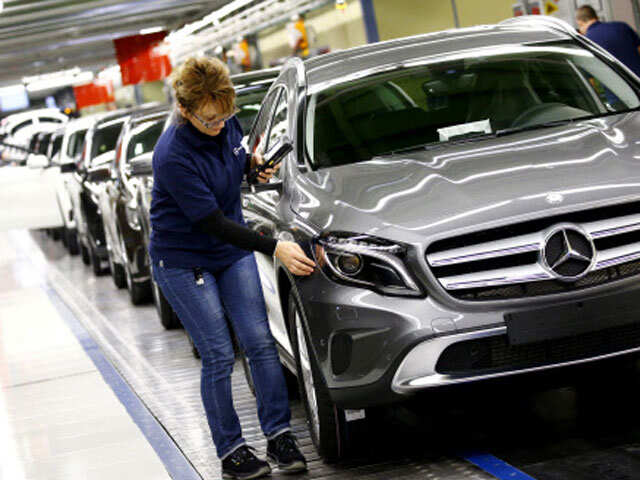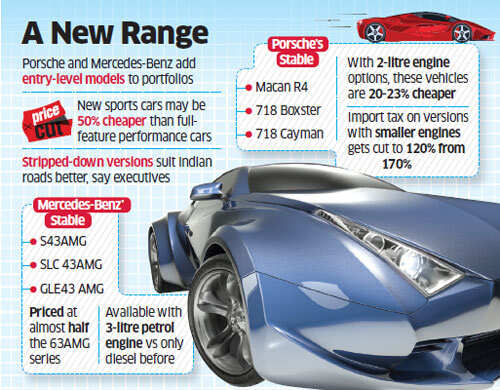 MUMBAI: It perhaps has never been so affordable to own a performance car in India. Iconic German sports car makers Porsche and Mercedes-Benz AMG added new, entry-level models to their portfolios, at prices as low as half those commanded by their full-feature performance cars. Tata Motors is building one of its own.
MUMBAI: It perhaps has never been so affordable to own a performance car in India. Iconic German sports car makers Porsche and Mercedes-Benz AMG added new, entry-level models to their portfolios, at prices as low as half those commanded by their full-feature performance cars. Tata Motors is building one of its own.Purists may have a problem with some of the stripped-down versions making their way into Ind ia — they don't tick all the boxes on performance expected from the road vehicles made for speed — but company executives say these cars suit better for Indian road and driving conditions.
In the past six months, Porsche drove in the Macan R4, 718 Boxster and 718 Cayman with 2-litre engine options. These vehicles are 20-23% cheaper than those fitted with the traditional 3-litre engines, because the lower displacement means a cut in import tax to 120% from the 170% levied on the versions with the larger engines.
Mercedes-Benz launched the S43AMG, SLC 43AMG and GLE43 AMG in the past 12 months, priced at almost half the 63AMG series.
These vehicles are now available with a 3-litre petrol engine, compared with only diesel before.
The enticing prices, the company says, have helped it attract buyers for performance cars in small cities and towns as well. Industry experts see entry-level models as a practical solution to meet the growing demand for hig h-performance cars in a country that is rapidly adding to its list of millionaires but where infrastructure development has failed to keep pace. With roads posing a challenge, very seldom a sports car buyer in India is able to drive the car to its fullest capacity, they say.
"A customer of C63 AMG is not able to get the real juice of the car in terms of performance due to challenges on road infrastructure, whereas the C43 AMG is much more practical and delivers a good mix of performance and practicality," said Roland Folger, the India head at Mercedes-Benz. "The 43 AMG will be a big driver of growth of our performance cars in India."
What d rove the automakers to come up with stripped-down versions of their performance cars was the curbs India imposed on vehicles powered by large diesel engines. A Supreme Court-imposed ban on diesel vehicles displacing more than 2 litres in the National Capital Region was lifted after six months last year, but that led the companies to be prepared for any such eventuality.
Luxury-car makers like Mercedes-Benz, BMW and Audi introduced sub-2-litre engine and petrol options and today these models have become a key part of their portfolio.Introduction of the 2-litre engine was a long-term counter strategy and the 2-litre, 4-cylinder strategy works brilliantly, said Pavan Shetty, head of the Porsche brand in India.
"You still have a product, comes very close to the competition and still can keep the business afloat in the best of times." Porsche's cars with 2-litre engines are getting strong traction in the market, he said. Already, the share of the 718 Cayman and Boxter in the company's India portfolio has increased to 15% from 5% and the Macan R4 is likely to see a five fold jump in sales to about 50 cars in 2017.
"The 2-litre cars should bring in incremental business of about 20% in 2017. Thanks to the overlying positive sentiment, we are looking at positive growth for first time in three years," said Shetty.
At Mercedes-Benz, the 43 AMG models have been the biggest contributor globally, too, to the more than 1 lakh cars it sold under the AMG portfolio in 2016. Both Mercedes-Benz and Porsche have lined up a number of vehicles for launch in India this year. Merc's plan comprises a dozen products, while Porsche is set to bring in the GT3 shortly.
Porsche, which plans also to add the Panamera diesel next year, has expanded its geographical reach with two new dealers in Chennai and Hyderabad. The company is exploring the possibility of starting smaller boutique outlets or small set-ups with a significant digital interface with the customers to reach out to towns and small cities.


No comments:
Post a Comment